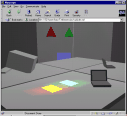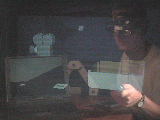Emmie - Environment Management for Multi-User Information Environments
Andreas Butz,
Tobias Höllerer,
Tom Dickes,
Blair MacIntyre,
Steven Feiner
|
|

|
Introduction
One important problem in multi-user virtual or
augmented reality environments, as well as in ubiquitous computing
environments, is the intelligent management of units of information,
such as text, images, and animation clips. In a conventional WIMP GUI,
these units of information are usually displayed as windows or
icons on a desktop, and are managed by some kind of window
manager. Window-management operations typically include moving,
opening, closing, and iconifying windows with a mouse. The manager
also provides means for starting applications, getting general or
context-sensitive help, or finding things in the environment.
Furthermore, some window managers provide basic functionality for the
automated arrangement and layout of windows and icons on the screen as
they are created (find a free place, tile, cascade). Once the windows are on
the screen, the functions provided for their automatic rearrangement are
either very simplistic (cascade/tile on request) or absent.
Objective
Our goal with the EMMIE system is twofold. The
first part is to provide services similar to those of a conventional
window manager in a Multi-User Augmented Environment in order to
create a simple and intuitive way of managing information units over
different displays and between several users manually. Since the
environment is inhabited by several users who can share certain
information units, but might want to have others only in their private
view of the environment, the additional issue of privacy vs. publicity
has to be addressed. Private information should not appear on publicly
visible displays, whereas public information has to be displayed on
public displays or shared between all of the private displays
(hand-held or head-mounted).
The second part is to actively assist the user by dynamic layout
mechanisms. Virtual objects should, for example, not occlude other
users or displays in the environment, unless explicitely placed
so. They can be attached to real world objects or people or to fixed
locations within the field of view.
Motivation
Several augmented reality application prototypes
have been built by the Computer Graphics and User Interfaces Lab at
Columbia over the past decade (e.g., see KARMA,
Windows
on the world, Architectural
Anatomy, and Augmented
Reality for Construction). These prototypes exhibit more and more
complexity, and essentially form heavily distributed ubiquitous
computing environments augmented by virtual objects. Our augmented
environments combine a variety of displays (hand-held, head-worn,
desk-top, and wall-sized) including both opaque and see-through, and
make use of many heterogeneous input devices. Our experience with them
has revealed a strong need for a general environment management
mechanism. The issues and notion of environment managment
were first discussed by Blair MacIntyre and Steven Feiner in their ´96
article "Future Multimedia User Interfaces" (see
publications). Environment management involves mechanisms for
dynamically changing the layout of virtual objects in the user's field
of view. The need for rearrangement became clear to us in our work on
Windows
on the world and "Hybrid user interfaces" (see
publications). In these projects we approached the limits of
statically placed virtual objects (either attached to real world
objects or fixed in space).
Scenario
One application scenario we imagine is a the management of
automatically generated multimedia presentations (see MAGIC)
for augmented Environments with different categories of
displays. Another one is a collaborative scenario, in which users of
an augmented environment hold a meeting with the help of this
environment. A third application area is the scenario of the National Tele-Immersion
Initiative.
Some Studies in VRML
 In order to do some brainstorming,
discuss and try out ideas we created some VRML97 models of
the Teleimmersion
scenario. These models show a possible transfer of the
window-desktop metaphor to 3D Augmented Reality Environments. As in
conventional window-desktop environments, in our augmented environment
there are documents and applications. Each document type as well as
each application has a visual representation in the form of a 3D
icon. In order to support existing 2D applications on computers
residing in the 3D environment, these applications have a 2D visual
representation in the form of a 2D icon. The operations on these icons
are similar to the ones known from the window-desktop metaphor, as for
example drag and drop or click to open.
In order to do some brainstorming,
discuss and try out ideas we created some VRML97 models of
the Teleimmersion
scenario. These models show a possible transfer of the
window-desktop metaphor to 3D Augmented Reality Environments. As in
conventional window-desktop environments, in our augmented environment
there are documents and applications. Each document type as well as
each application has a visual representation in the form of a 3D
icon. In order to support existing 2D applications on computers
residing in the 3D environment, these applications have a 2D visual
representation in the form of a 2D icon. The operations on these icons
are similar to the ones known from the window-desktop metaphor, as for
example drag and drop or click to open.
In addition to the operations and services known from conventional
window managers, a Multi-User Augmented Environment requires dealing
with the issue of privacy vs. publicity. Not every item in one user's
personal view of the environment should necessarily be visible to
every other user. On the other hand we sould be able to display some
items publicly in order to discuss them with other users. We have
developed and discussed several approaches to that, two of which are
actually implemented in the VRML worlds.
Implementation
 We are currently implementing a prototype of
an information manager for Multi-User Augmented Information
Environments. The implementation uses the lab's distributed graphics
programming environment COTERIE
and is running on different kinds of Unix as well as on Windows NT. It
integrates wall-sized displays as well as
conventional PCs, Laptops and workstations together with see-through
head mounted displays into one Augmented Environment in which
information units can be presented in multiple ways and passed between
machines. On the left is a snapshot of the current system, taken with a camera looking through a head mounted display.
We are currently implementing a prototype of
an information manager for Multi-User Augmented Information
Environments. The implementation uses the lab's distributed graphics
programming environment COTERIE
and is running on different kinds of Unix as well as on Windows NT. It
integrates wall-sized displays as well as
conventional PCs, Laptops and workstations together with see-through
head mounted displays into one Augmented Environment in which
information units can be presented in multiple ways and passed between
machines. On the left is a snapshot of the current system, taken with a camera looking through a head mounted display.
Publications
A. Butz, T. Höllerer, S. Feiner, B. MacIntyre, C. Beshers,
Enveloping Users and Computers in a Collaborative 3D Augmented
Reality, In: Proc. IWAR '99 (Int. Workshop on Augmented Reality),
San Francisco, CA, October 20-21, 1999, pp. 35-44
(
1.1MB Acrobat version of paper)(
2.6MB gzipped Postscript version of paper)
Acknowledgements
This research is supported by the German
Academic Exchange Service, the National Tele-Immersion
Initiative; the Office of Naval Research under Contract
N00014-97-1-0838; hardware and
software gifts from Intel, Mitsubishi Electric Research Labs and Microsoft;
the New York State Center for Advanced Technology in
Computers and Information Systems under Contract NYSSTF-CAT-92-053;
and NSF Grant CDA-92-23009. The working environment,
hardware, infrastructure and technical support are provided by the Computer Graphics
and User Interfaces lab at Columbia University, New York


 In order to do some brainstorming,
discuss and try out ideas we created some VRML97 models of
the Teleimmersion
scenario. These models show a possible transfer of the
window-desktop metaphor to 3D Augmented Reality Environments. As in
conventional window-desktop environments, in our augmented environment
there are documents and applications. Each document type as well as
each application has a visual representation in the form of a 3D
icon. In order to support existing 2D applications on computers
residing in the 3D environment, these applications have a 2D visual
representation in the form of a 2D icon. The operations on these icons
are similar to the ones known from the window-desktop metaphor, as for
example drag and drop or click to open.
In order to do some brainstorming,
discuss and try out ideas we created some VRML97 models of
the Teleimmersion
scenario. These models show a possible transfer of the
window-desktop metaphor to 3D Augmented Reality Environments. As in
conventional window-desktop environments, in our augmented environment
there are documents and applications. Each document type as well as
each application has a visual representation in the form of a 3D
icon. In order to support existing 2D applications on computers
residing in the 3D environment, these applications have a 2D visual
representation in the form of a 2D icon. The operations on these icons
are similar to the ones known from the window-desktop metaphor, as for
example drag and drop or click to open.
 We are currently implementing a prototype of
an information manager for Multi-User Augmented Information
Environments. The implementation uses the lab's distributed graphics
programming environment COTERIE
and is running on different kinds of Unix as well as on Windows NT. It
integrates wall-sized displays as well as
conventional PCs, Laptops and workstations together with see-through
head mounted displays into one Augmented Environment in which
information units can be presented in multiple ways and passed between
machines. On the left is a snapshot of the current system, taken with a camera looking through a head mounted display.
We are currently implementing a prototype of
an information manager for Multi-User Augmented Information
Environments. The implementation uses the lab's distributed graphics
programming environment COTERIE
and is running on different kinds of Unix as well as on Windows NT. It
integrates wall-sized displays as well as
conventional PCs, Laptops and workstations together with see-through
head mounted displays into one Augmented Environment in which
information units can be presented in multiple ways and passed between
machines. On the left is a snapshot of the current system, taken with a camera looking through a head mounted display.